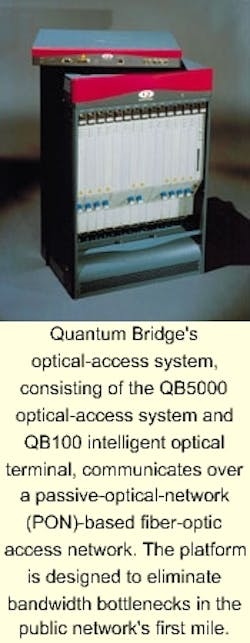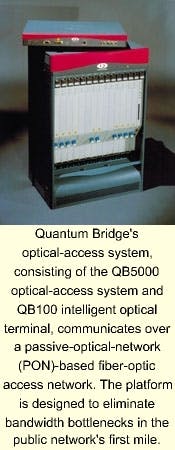Quantum Bridge's optical-access system aims at the 'optical-bypass' market
By ROBERT PEASE
Quantum Bridge (North Andover, MA) has unveiled its flagship optical-access system designed to eliminate bandwidth bottlenecks existing in the public network's first mile. The system, consisting of the QB5000 Optical Access Switch (OAS) and the QB100 Intelligent Optical Terminal (IOT), enables competitive service providers to economically bring high-bandwidth services to businesses of all sizes.
This target market is referred to by a Current Analysis Inc. competitive-intelligence report as the "optical-bypass" market. Service providers such as cable operators have long bypassed commercial business opportunities without a strong business case for addressing these potential customers."Quantum Bridge and some other startups have developed cost-effective solutions that enable service providers to utilize unused fiber resources or to extend existing fiber installation the last mile or so in order to provide services," says Chris Nicoll, senior analyst at Current Analysis. "Most of the new locations being addressed are not suitable for SONET [Synchronous Optical Network] due to the expense of SONET equipment."
The Quantum Bridge solution provides businesses with services ranging anywhere from 1 to 100 Mbits/sec, to dedicated wavelengths, up to nearly 100 times the speeds provided by existing solutions, such as T1 lines or cable-modem technologies. Comcast Corp., a provider of data, Internet, and voice solutions to business customers, is the first broadband service provider to trial the new system. Scalability was a key attraction for Comcast.
"The technologies exploited by Quantum Bridge's optical-access system can scale in terms of access bandwidth," says Stephen Linskey, vice president of telecommunications technology at Comcast. "That capability provides the 'elastic bandwidth' to meet our customers' future service requirements."
The two system elements, the QB100 IOT and QB5000 OAS, communicate over a passive optical network (PON)-based fiber-access network. PON infrastructure requires no active electronics in the outside plant, drastically reducing cost while allowing a broad optical-access footprint to be established and leveraged (see Lightwave, November 1999, page 82).
The QB100 IOT, located at the customer premises, is equipped with four DS-1 and one 10/100Base-TX customer-service interfaces to allow businesses to leverage a high-capacity PON for both voice and high-bandwidth data services. In a typical deployment, the QB100 represents the point of demarcation between the service-provider network and the business customer network, directly connecting to an enterprise router, ATM edge switch, local area network (LAN), frame-relay access device (FRAD), or private branch exchange (PBX) at the customer site.
The QB5000 OAS is located in the service provider's central office, head-end, or point-of-presence (POP). This switch aggregates traffic from hundreds of QB100s across a PON, providing a variety of efficient optical wide-area-network (WAN) interfaces. It supports Asynchronous Transfer Mode (ATM), packet over SONET (POS), Gigabit Ethernet, and VT1.5-formatted optical interfaces. The system's plug-and-play modules and software enable nondisruptive rapid service provisioning in support of a variety of service offerings. The integrated management capabilities-built into the core operating system software-supply the intelligence required to support hundreds of diverse end-user services.
Expanding on the benefits of PON architecture, Quantum Bridge's dynamic wavelength slicing (DWS) protocol makes it possible to share a wavelength, thus delivering broadband service among multiple end points. DWS enables service providers to "slice" a single wavelength to be used by multiple businesses or dedicate an entire wavelength to a single business, depending on the unique needs of each business customer.
By definition, says Nicoll, service providers using Quantum Bridge's technology are laying fiber instead of copper. Since the future of networking is most likely going to require higher speeds and capacities, installing fiber now is a way of futureproofing a carrier's access networks, especially since the access line is usually the bottleneck.
"Even if there is no cost differential compared to a competing copper-based solution, service providers are likely to be more willing to install Quantum Bridge's solution initially," says Nicoll. "They are under the expectation that they can easily grow Quantum Bridge-based services in the future due to the flexibility of these new products."
While overall the Quantum Bridge solution is timely, cost-effective, and very scalable, Nicoll points out a few potential concerns with the new platform. Quantum Bridge has pushed the routing and traffic prioritization capabilities to the central office or POP rather than to the customer-premises equipment (CPE) and POP.
"Getting an end-to-end view of performance requires linking the CPE router and Quantum Bridge 5000 SLM stats, which could result in gaps in reporting," says Nicoll. "Additionally, should service providers continue to integrate their protocol services, such as voice switching, with their transport systems, Quantum Bridge and most of its competitors may need to retool their products."
Overall, analysts give high marks to Quantum Bridge's first platform. Current Analysis is very positive on the system, primarily for offering a competitive solution at price points that are better than those announced by its competitors. The system can be deployed for a list price of $7,000 per customer served. The company will make the platform commercially available in the second quarter of 2000.
"Every now and then, someone comes up with a concept that could really change the rules in networking," says Tom Nolle, principle analyst at CIMI Corp., an industry analyst firm. "Quantum Bridge has done that. By making inexpensive PON optics compatible with two-way business and residential network applications, their architecture could relieve a limitation on traffic that's probably the largest limitation to customer network value and provider network revenue."

